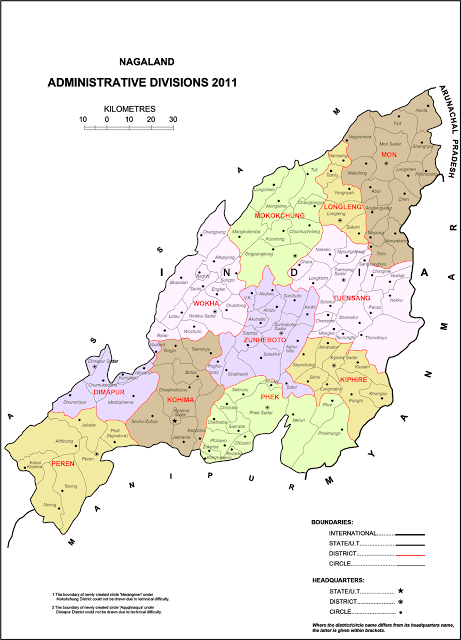 |
| History of Nagaland |
Many scholars argue that Naga people arrived from East Asia to the present location of Nagaland in different phases. This resulted in the development of unique customs, traditions, attire, language and political system of each tribe. As of now, the Government of India recognizes 14 major Naga tribes and this number can go up to 35 if Naga sub-tribes are included.
Until the arrival of Britishers in the nineteenth century, Naga people had no or little contact with the outside world, with sole exception to Ahoms. Prior to the invasion of Ahoms, Dimasa Kachari is said to rule the present area of Nagaland. From the middle of the thirteenth century until the arrival of the British, Ahoms exercised the supremacy over the Naga areas. However, they never annexed the area in their kingdom. It was in 1828, Britain annexed Assam, Manipur and a major chunk of present Burmese territory following First Anglo-Burmese War and Treaty of Yandabo, and with this, the Britishers came into the contact of Naga people.
In 1832, for the first time, two British explorers, Captain Jenkins and Lieutenant Pemberton, entered the areas of Naga Hills. The early years of British and Naga contact were filled with constant aggression. However, in 1845, the Britishers were able to make a non-aggression pact with Naga chiefs. The pact did not last long and aggression ensued from both sides. The Battle of Khonoma (1850) and Battle of Kikurma (1851) are prime examples of this hostility.
It was in 1866, the British officially carved out Naga Hills district within the state of Assam for the better control and administration of the area. The new district was also formed with a mindset to develop tea plantation in this area. However, this step ensued further hostility between the colonizers and Naga tribes as Nagas sought this step to mark down them.
The hostility between the Nagas and the colonizers reached a new height in 1879 with the Battle of Khonoma (1879-80). This time the British responded with brutality and attacked, looted and killed the non-warring population to subjugate Naga warriors.
Nagas always maintained resistance from outside culture. Even within themselves, they not used to intermingle. However, this all changed after the British invasion. After the battle of Khonoma, different Naga tribes come under one roof and there was a popularization of the Naga identity. In 1918, an educated group of Naga people formed Naga Club and they were first who openly demanded separation from India. The demand for separate state fueled when the British Government announced its Independence plan of India. The Angami-Zapu-Phizo formed the Naga National Council (NNC) and demanded separation from separate India. This led to the famous 9 point agreement or also known as Naga-Akbar Hyadri Accord, which allowed judicial, executive and legislative freedom as well as autonomy in land-related matters to Nagas for a period of ten years. They were also promised a united Naga district. The agreement led to the successful formation of a unified Naga territory, Naga Hills Tuensang Area, but failed on the definition of territorial powers. The Government of India accepted Naga demand to rule the territory according to their personal laws and custom, but as a territory of India, but on another hand, Naga separatist wants a separate state with India as a guardian state. This result in an insurgency in the area.
In 1960, the peace talks begin again between the Government of India and the Naga People's Convention. A sixteen-point agreement arrived whereby the Government of India recognized the formation of Nagaland, a full-fledged state within the territory of India. In February 1962, Naga Hills Tuensang Area was renamed as Nagaland. On 1 December 1963, Nagaland became the 16th state of India with special constitutional guarantee to the Naga people under Article 371A and other provisions. As of 2019, the Nagaland is divided into 12 districts and several administrative blocks. This step was praised by many Naga people and led to the Ceasefire Agreement in 1964. However, there were few skirmishes from both sides which led to the cessation of the Ceasefire Act in 1972. However, the peace talks again resumed with the promulgation of President rule in 1975. These renewed peace talk led to the Shillong Accord (1975) and the Ceasefire Agreement was again reached between Government of India and the Separatist Group in 1997. The pressure groups such as the Naga Mothers Association played an important role in bringing peace to the land.
